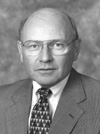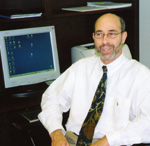Research development marks 8 years'
growth
As MUSC Foundation for Research Development director Ken Roozen, Ph.D.,
transfers foundation management to a new director, he steps aside
having enjoyed his tenure at MUSC and with a degree of satisfaction in
what the foundation has accomplished in its eight-year existence. Dr. Ken Roozen
Dr. Ken Roozen“We began foundation activities in earnest in the summer of 1997,” Roozen said, “and it’s been terrific to see the growth in research programs at MUSC and economic development programs in the state.”
It’s research program growth that provides the fuel for the foundation’s efforts to guide new ideas, technology and expertise created at MUSC through the entrepreneurial maze into the private sector that turns them into commercial products and services available for public use and benefit. Since 1997, the foundation received 389 invention disclosures and invested in 137 patent applications to protect those discoveries. But most important, said Roozen, “To date more than 40 options and licenses to new and existing companies have resulted from these discoveries.”
Roozen hails Micrus Corporation in Sunnyvale, Calif., as a prime example of technology birthed in MUSC labs that led to the creation of a new company and now has found its way into production and public use. “This has been a real win. The foundation has received license payments and equity, and patients with aneuryms are being helped by stents developed by Joseph Horton, M.D., and Diana Vincent, Ph.D.” Unfortunately the company, which manufactures and markets the implantable medical device used in the treatment of cerebral vascular diseases, sprouted in the more favorable economic climate of California at a time when conditions were less favorable in South Carolina.
“Micrus, the state’s first university spinoff company to go public, is terrific technology that was conceived in 1996 when there was no real infrastructure for the birth and development of a medical technology company in South Carolina,” Roozen said. He explained that since that time the state has taken steps that would nurture biotechnology start-ups and welcome companies that would locate here.
“There’s finally a real interest in invention and discovery as a route to economic development in South Carolina. We are seeing the university build and open new facilities. The state has begun to create a public policy environment conducive to the creation, recruitment, and growth of technology companies.” He cited the Centers of Economic Excellence, the Venture Capital Act, University Research Facilities Act and the South Carolina Research Innovation Act, as examples of such factors needed for South Carolina to be active and competitive in the technology arena.
“Had there been access to venture capital and incubator facilities in 1997, Micrus might have happened here,” Roozen said. “It takes more than good innovation to create companies, jobs, and wealth,” and happen as they do in Boston, San Francisco, San Diego and North Carolina’s Research Triangle.
“Researchers are driven by their passion for science and research and hope in their heart of hearts that their discovery will help people, but for it to obtain private sector attention a potential product or service also must be economically and commercially viable. This is not always easy for investigators to understand.”
Newer companies have since arisen in the Micrus tradition, but have formed state connections. Argulyn, a pharmaceutical company located in Charleston, has received several federal grants to develop and test its technology under the Small Business Innovation Research (SBIR) grant program. “The competition for these grants is keen and based on the quality of the company and the quality of the technology,” Roozen said. “That’s a measure of the company’s ability to conduct the proposed work and the likelihood its development will lead to a useful product.”
He said that Argulyn’s SBIR phase 1 awards generally amount to funding up to about $150,000, but where things really become significant—and the competition even tougher—is for phase 2 awards. In this case, Argulyn’s phase 2 award is in excess of $1 million. What it means for MUSC’s Foundation for Research Development is that more than a million dollars will be applied to expand a technology developed at MUSC by Tom Dix, Ph.D., and now licensed to Argulyn. This makes it more likely that the invention will become a useful product.
Two other companies, Cephos and Onconix, which were formed to further develop and commercialize MUSC inventions, have recently received investment funding from angel partnerships. These are groups of investors who prefer to invest in small, early stage companies, and their investment signifies their belief in the market potential of the technology. Cephos’ technology is based on a new method to detect deception, developed by Mark George, M.D., and Andy Kozel, M.D. Oconix technology is a diagnostic test for early detection of cervical cancer, developed by Subbi Mathur, Ph.D. Overall more than a dozen new companies were created around MUSC technology licenses.
As an example of a significant discovery licensed to an existing company, Roozen noted a license to a major pharmaceutical company. In this case the discovery by Inderjit Singh, Ph.D., that statins have anti-inflammatory effects led to an issued patent and a license for its use in certain neurodegenerative diseases.
License and option revenues, which are payments received by the foundation for rights to a license or an option to intellectual property created at MUSC, have increased from near insignificance in 1998 to more than $1 million annually.
Licenses are legal agreements that transfer the rights from MUSC and the foundation to a private company. Roozen explained that this is done in exchange for payments, part up front and part usually based on sales—from the company to MUSC and/or the foundation. Implicit in the payment for a license is the company’s belief that the invention or technology has commercial potential and will ultimately be a product or service people will buy. Not only does the company pay MUSC or the foundation for the rights to develop the invention or technology, they also commit to do things not generally done in a university such as test, make, market, and distribute the product or service. Total option and license revenues received by the foundation now exceed $4.5 million with more than $1 million of those revenues being distributed to the inventors in recognition of their discovery.
An additional $2.5 million has been distributed by the foundation to MUSC inventor laboratories, departments, and the University Research Fund managed by the provost.
The future also appears bright. In 2005, the foundation reported term sheets were completed for three possible new spin-off companies. Early in the negotiation process leading to a license is the creation of a term sheet that defines license terms and signifies a company’s interest in obtaining a technology or invention.
Term sheets can be with existing companies or with individuals who anticipate forming or founding a new company, a spin-off. In the case of spin-offs, term sheets generally foretell the creation of yet another MUSC spin-off company, which may eventually be acquired or have an initial public offering (IPO) which will generate real monetary value. The foundation also reported four new licenses and three terms or draft licenses completed with existing companies.
Roozen points out that like many of the new companies mentioned earlier, the foundation has been in a “start-up” mode. “Hopefully the advocacy, efforts, and results of the foundation’s first eight years have established a momentum which will provide increasing benefits to MUSC and its staff, the community, and the public,” Roozen said. “The ultimate goal is consistent with the role of the university and includes human health improvement as well as economic enrichment through job and wealth creation.”
FRD director cites growth, admin. support
Robert I. Pozner, Ph.D., here from the Office of Technology Development at the University of North Carolina at Chapel Hill, has taken the helm at the Foundation for Research Development to serve as director of technology transfer and as the foundation’s interim executive director.He replaces Ken Roozen, Ph.D., who for eight years nurtured the foundation from its birth to become a driving force in bringing MUSC technology to public use.
 Dr. Robert Pozner
Dr. Robert Pozner“This is where I want to be,” Pozner said during a get-acquainted interview last month as he settled into his office at Cannon Park Place. “The operation at Chapel Hill is practically self-sustaining and with everything in place there, I would have had a maintenance role. I’m not built that way.” He said that MUSC’s growth in research, the support and commitment from the university’s administration and the clear opportunity to build on the groundwork Roozen has in place influenced his decision.
From his recent position as senior associate director of the UNC Office of Technology Development, from similar positions at North Carolina State and the Triangle Universities Licensing Consortium and from a decade of experience in marketing and technical management in the corporate sector, Pozner brings with him a momentum that promises to enhance MUSC’s position among research universities nationwide.
Pozner said his primary activities will center on licensing MUSC technology and intellectual property to existing companies, the creation of start-up companies, and nurturing research relationships with the corporate sector and with other universities and research centers, all with the aim to get university technology commercialized for the public’s and the university’s benefit.
Beyond this, MUSC has an opportunity to be at the forefront of using its technology for social good, Pozner said. Describing a trend that he says is picking up steam, Pozner said he would like to use intellectual property to treat orphan diseases and diseases in developing countries. Orphan diseases and the diseases that can paralyze nations struggling to develop their economies hold little promise of return on investment, but offer huge rewards in the relief of suffering and in drawing attention to the university’s research acumen, he said.
Pozner’s office is located on the third floor of Cannon Park Place on Calhoun Street above Port City Java and Eckerd’s.
The Foundation for Research Development Web site is http://www.musc.edu/frd/. He can be reached by e-mail at pozner@musc.edu at 876-1900.
Friday, Sept. 23, 2005
Catalyst Online is published weekly,
updated
as needed and improved from time to time by the MUSC Office of Public
Relations
for the faculty, employees and students of the Medical University of
South
Carolina. Catalyst Online editor, Kim Draughn, can be reached at
792-4107
or by email, catalyst@musc.edu. Editorial copy can be submitted to
Catalyst
Online and to The Catalyst in print by fax, 792-6723, or by email to
petersnd@musc.edu
or catalyst@musc.edu. To place an ad in The Catalyst hardcopy, call
Community
Press at 849-1778.